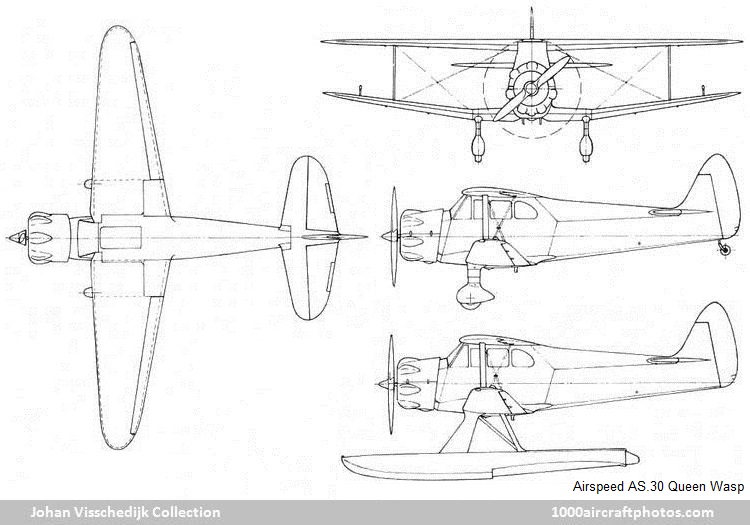The Queen Wasp, much too good-looking to be shot out of the sky, was a single-bay biplane with folding wings, mainly of wood construction, and powered by a 350 hp Armstrong Siddeley Cheetah IX seven-cylinder radial. The center section was built integrally with the fuselage, and the outer wings were of two-spar ply-covered construction with fabric covered slotted flaps and ailerons. The fuselage was in three sections, with the middle portion carrying the center section.
Access to the single-seat cockpit was by way of a door in the starboard side between the spar-mounted bulkheads. A transparent sliding panel in the roof between the bulkheads and spars provided access to the slinging gear and wing-joint pins and served also as an emergency exit. Slotted flaps were fitted to the trailing edge of the top wing, extending over the whole outer spans. Slotted ailerons were on the lower wing only and were interconnected with the flaps so that these and the ailerons were lowered together.
Two prototypes, K8887 with a land landing gear and K8888 with floats, were built and flown in 1937. The landplane prototype made its initial flight, in the hands of G.B.S. Errington, from Portsmouth Airport on June 11, 1937, and was seen publicly for the first time at the RAF Display, Hendon, at the end of that month among the new and experimental aircraft. The seaplane prototype was flying soon afterwards and was successfully catapulted from the carrier HMS Pegasus (ex-HMS Ark Royal) in November.
Those who flew the later Queen Wasps say that the slow-speed characteristics were not all that could be desired, however, both the landplane and seaplane prototypes survived the test-flying period without serious mishap. The first flight of the seaplane was made by Flight Lieutenant C.H.A. Colman, who had never previously handled either a floatplane or flying boat. Incidentally, in tank tests at Farnborough the original Short-built floats were found to be unsatisfactory because of pitching instability. After the RAE had developed a better design, Shorts produced their own alternative which, after some modifications, was equally satisfactory.
In automatic flight the Queen Wasp was controlled by an air-driven gyroscope unit which maintained the status quo by corrections made through pneumatic servos to the rudder and elevator (the ailerons were locked in the neutral position). Changes of heading or attitude, as signaled by radio from the ground with coded dot-dash signals, were made by suitably processing the gyro with a system of air-driven pistons. There were three radio-controlled throttle positions-fully open, half open for cruise power, and closed. The throttle movement was interconnected with a complicated device to counteract the effects of acceleration and deceleration on the gyro. A servo motor lowered the flaps when 'landing glide' was demanded by radio signals, but only when the speed was right. Regardless of any lack of radio instructions an altimeter contact system automatically initiated a pull-out to the fast level full-throttle condition below a pre-set altitude.
A weighted trailing aerial, automatically winched out by air-speed-indicator signal after take off or catapulting, served the dual purpose of radio aerial and automatic-landing activator. When the weight struck the ground, contacts on the winch caused an electrically operated spring-loaded valve to apply up elevator and short-circuited all air supplies to the gyroscope and other valves. When the aerial touched, the Queen Wasp was thus committed finally to its own landing, for better or for worse.
This relatively straightforward auto landing system, however, provided problems of its own. In very bumpy weather the trailing aerial could snatch sufficiently vigorously to give the unthinking system the idea that a landing should be initiated. So a relay was introduced into the system to forestall automatic action before a 'landing glide' signal had been received.
When serious failures occurred the systems were arranged for the aircraft to enter a flaps-down engine-off glide in a gentle left turn, so that, at the worst, an automatic landing might be made not too far from base. Engine failure left the Queen Wasp in a flaps-down glide in a slow turn to port. Battery failure left it in a flaps-up glide-also in a slow turn to port. As a Farnborough note said: 'The aeroplane will almost certainly crash, but the flying range is limited.' To deal with radio failure, the system included a clock which, reset by all incoming signals, selected the emergency glide condition if no signals had been received after an elapsed period of two minutes.
Five production Queen Wasps (serial P5441 to P5445) were completed and delivered to the RAF. The first of these flew on March 29, 1940, and the second on May 18, 1940. The RAF serial numbers allocated shows that the expected requirement was for 325, including the two prototypes, however, only five more Queen Wasps, serial P5446 to 5450, were partially completed, before production was cancelled."

